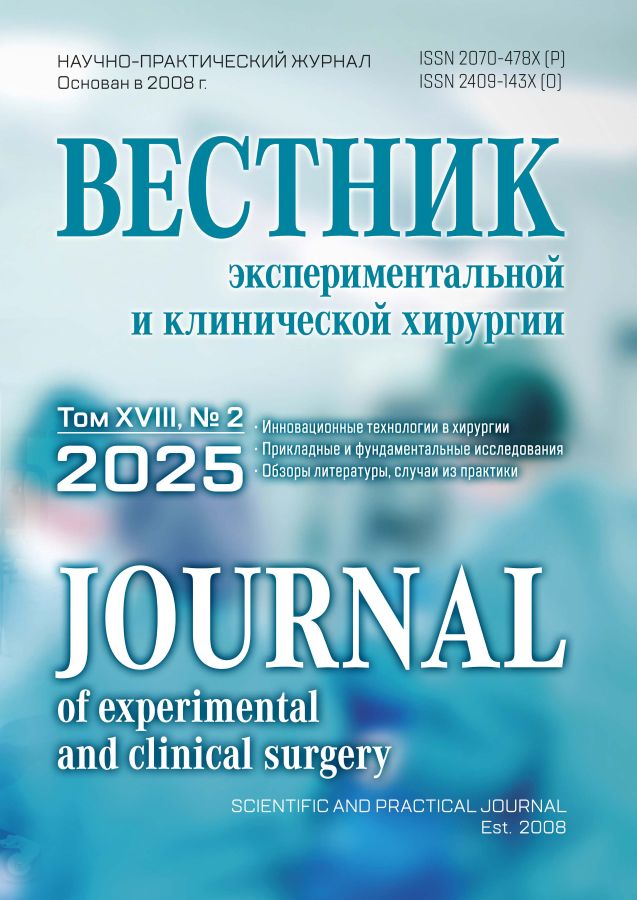Anesthesia and Analgesia in Laboratory Rats: Combinations of Drugs Applied, their Effects on Animals, Optimal Solutions for Reducing Side Effects
- Authors: Matveev N.L.1,2, Kupriyanova A.S.1,2, Armashov V.P.1,2, Efimova I.V.1,3, Loseva V.V.1, Lystseva A.V.1
-
Affiliations:
- Pirogov Russian National Research Medical University
- Loginov Moscow Clinical Scientific Center
- Preclinical Research Center
- Issue: Vol 18, No 2 (2025)
- Pages: 166-175
- Section: Review of literature
- URL: https://vestnik-surgery.com/journal/article/view/1801
- DOI: https://doi.org/10.18499/2070-478X-2025-18-2-166-175
- ID: 1801
Cite item
Abstract
Currently, a great number of research studies, including those involving surgical interventions, is carried out on experimental models demonstrating pathological processes in rats. In this regard, there is a need for effective and time-controlled techniques of anesthesia and analgesia applicable to a selected group of animals, with subsequent assessment of the anatomical and physiological effects of the selected drug combination. The available options for general anesthesia are distributed in a wide range by the nature of their effect, the duration of action, the process of postoperative recovery within the framework of specific experimental models. This provides relevant search for the most effective and safe drugs. The article discusses the principles of anesthesia in experimental animals (rats), and the most common drugs and their combinations, including isoflurane, a combination of ketamine-xylazine and other ketamine combinations; the effect of a combination of medetomidine, midazolam and butorphanol, the effect of sodium phenobarbital and the use of chloralose are described. All the above drugs are used for anesthesia and analgesia during surgical interventions on experimental models. Notably, besides anesthetic and analgesic effects on the animal's body, they also cause changes in a number of physiological functions, including the work of the heart, brain and respiratory organs, thus, being key factors in the deterioration of the recovery process of animals in the postoperative period or causing animals’ death during the experiment.
Full Text
About the authors
Nikolay L. Matveev
Pirogov Russian National Research Medical University; Loginov Moscow Clinical Scientific Center
Author for correspondence.
Email: n.l.matveev@gmail.com
M.D., Professor, Head of the Department of Experimental and Clinical Surgery of Department of Biomedicine; Surgeon at the Department of General Surgery
Russian Federation, Moscow; MoscowAlina S. Kupriyanova
Pirogov Russian National Research Medical University; Loginov Moscow Clinical Scientific Center
Email: almalisa07@gmail.com
Assistant at the Department of Experimental Surgery of the Department of Biomedicine; Surgeon at the Department of General Surgery
Russian Federation, Moscow; MoscowVadim P. Armashov
Pirogov Russian National Research Medical University; Loginov Moscow Clinical Scientific Center
Email: armashovvp@mail.ru
Ph.D., Associate Professor at the Department of Experimental Surgery of the Department of Biomedicine; Senior Researcher at the Department of High-Technology Surgery and Surgical Endoscopy, Surgeon at the Department of General Surgery
Russian Federation, Moscow; MoscowIrina V. Efimova
Pirogov Russian National Research Medical University; Preclinical Research Center
Email: 3198789@mail.ru
Engineer at the Advanced Engineering School; Manager
Russian Federation, Moscow; PenzaValeria V. Loseva
Pirogov Russian National Research Medical University
Email: valeria_0315@mail.ru
Student of the Department of Biomedicine
Russian Federation, MoscowAlexandra V. Lystseva
Pirogov Russian National Research Medical University
Email: aleksandra.lyst@gmail.com
Student of the Department of Biomedicine
Russian Federation, MoscowReferences
- Steiner AR, Rousseau-Blass F, Schroeter A, Hartnack S, Bettschart-Wolfensberger R. Systematic Review: Anesthetic Protocols and Management as Confounders in Rodent Blood Oxygen Level Dependent Functional Magnetic Resonance Imaging (BOLD fMRI)-Part B: Effects of Anesthetic Agents, Doses and Timing. Animals (Basel). 2021; 11: 199. doi: 10.3390/ani11010199
- Diana P, Joksimovic SM, Faisant A, Jevtovic-Todorovic V. Early exposure to general anesthesia impairs social and emotional development in rats. Mol Neurobiol. 2020; 57: 41-50. doi: 10.1007/s12035-019-01755-x
- Liu Y, Fu HQ, Wu Y, Du ZS, Li BR, Gao X, Lin GW, Yang SY, Wang TL. Influence of three different anesthesia protocols on aged rat brain: a resting-state functional magnetic resonance imaging study. Chin Med J (Engl). 2020; 134: 344-352. doi: 10.1097/CM9.0000000000001126
- Farag A, Mandour AS, Hendawy H, Elhaieg A, Elfadadny A, Tanaka R. A review on experimental surgical models and anesthetic protocols of heart failure in rats. Front Vet Sci. 2023; 10. doi: 10.3389/fvets.2023.1103229
- Farag A, Mandour AS, Hamabe L, Yoshida T, Shimada K, Tanaka R. Novel protocol to establish the myocardial infarction model in rats using a combination of medetomidine-midazolam-butorphanol (MMB) and atipamezole. Front Vet Sci. 2022; 9. doi: 10.3389/fvets.2022.1064836
- Pawela CP, Biswal BB, Hudetz AG, Schulte ML, Li R, Jones SR, Cho YR, Matloub HS, Hyde JS. A protocol for use of medetomidine anesthesia in rats for extended studies using task-induced bold contrast and resting-state functional connectivity. Neuroimage. 2009; 46: 1137–1147.
- Chao THH, Chen JH, Yen CT. Repeated bold-fmri imaging of deep brain stimulation responses in rats. PLoS ONE. 2014; 9.
- Ochiai Y, Baba A, Hiramatsu M, Toyota N, Watanabe T, Yamashita K. Blood biochemistry and hematological changes in rats after administration of a mixture of three anesthetic agents. J Vet Med Sci. 2018; 80: 387–394. doi: 10.1292/jvms.17-0497
- Sorrenti V, Cecchetto C, Maschietto M, Fortinguerra S, Buriani A, Vassanelli S. Understanding the Effects of Anesthesia on Cortical Electrophysiological Recordings: A Scoping Review. Int J Mol Sci. 2021; 22. doi: 10.3390/ijms22031286
- Caetano J, Alves JD. Heart rate and cardiovascular protection. Eur J Int Med. 2015; 26: 217-222. doi: 10.1016/j.ejim.2015.02.009
- Svorc P, Svorc P Jr. General anesthesia and electrocardiographic parameters in in vivo experiments involving rats. Physiol Res. 2022; 71: 177-192. doi: 10.33549/physiolres.934848
- Sajovic J, Trandafilović M, Drevenšek G, Kužner J, Drevenšek M. Frequently applied ketamine, medetomidine and thiopental anaesthesia induces high mortality in Wistar rats. Eur Rev Med Pharmacol Sci. 2022; 26: 158-167. doi: 10.26355/eurrev_202201_27765
- Mechelinck M, Kupp C, Krüger JC, Habigt MA, Helmedag MJ, Tolba RH, Rossaint R, Hein M. Oxygen inhalation improves postoperative survival in ketamine-xylazine anaesthetised rats: An observational study. PLoS One. 2019; 14. doi: 10.1371/journal.pone.0226430
- Albrecht M, Henke J, Tacke S, Markert M, Guth B. Influence of repeated anesthesia on physiological parameters in male Wistar rats: a telemetric study about isoflurane, ketamine-xylazine and a combination of medetomidine, midazolam and fentanyl. BMC Vet Res. 2014; 10: 310. doi: 10.1186/s12917-014-0310-8
- Livingston A, Waterman A. The development of tolerance to ketamine in rats and the significance of hepatic metabolism. Br. J. Pharmacol. 1978; 64: 63–69.
- Furuyama F, Murakami M, Oiwa T, Nishino H. Differences in Thermal Salivation between the FOK Rat (a Model of Genotypic Heat Adaptation) and Three Other Rat Strains. Physiol Behav. 1998; 63: 787-793.
- Klemcke HG, Calderon ML, Crimmins SL, Ryan KL, Xiang L, Hinojosa-Laborde C. Effects of ketamine analgesia on cardiorespiratory responses and survival to trauma and hemorrhage in rats. J Appl Physiol. 2021; 130: 1583-1593. doi: 10.1152/japplphysiol.00476.2020
- Li C, Peng J, Hu R, Yan J, Sun Y, Zhang L, Liu W, Jiang H. Safety and Efficacy of Ketamine Versus Ketamine-Fentanyl-Dexmedetomidine Combination for Anesthesia and Analgesia in Rats. Dose Response. 2019; 17. doi: 10.1177/1559325819825902
- Zhou X, Li W, Wang H, Li C, Jiang H. Safety and Efficacy of Ketamine-Fentanyl-Dexmedetomidine-Induced Anesthesia and Analgesia in Neonatal and Aged Rats. Dose Response. 2021; 19. doi: 10.1177/15593258211063987
- Silverman J, Muir WW 3rd. A review of laboratory animal anesthesia with chloral hydrate and chloralose. Lab Anim Sci. 1993; 43: 210-216.
- Paasonen J, Salo RA, Huttunen JK, Gröhn O. Resting-state functional mri as a tool for evaluating brain hemodynamic responsiveness to external stimuli in rats. Magnet. Reason. Med. 2016; 78: 1136–1146.
- Flecknell P. Laboratory Animal Anaesthesia. Academic Press: Cambridge. MA. USA. 2015.
Supplementary files















